| home | work | cv | about | texts | contact |
Comment to the sound artistic works of Dagmar Articus geb.Kriegesmann
End of sixties: The Canadian composer and educator R. Murray Schafer created and published the term “soundscape”, he focused herewith the listening conscience on “sound as environment – environment as sound” and thus on the acoustical cover, which encloses the human in everyday life. That the world is sound, that noises of everyday life are aesthetic being comprehended as music, this attitude was adopted by John Cage. Initially Schafer´s “Soundscape”-model, however, clarifies that any space, any figure and any situation is acoustically manifested. The listening-into-the-world establishes the perceiving person contact to the representations of this world.
These acoustic representations, however, “speak” in a different way about our world as the visible matter.
That listening to the environment can unveil aspects of itself commonly hidden for us manifested especially through Max Neuhaus´ “Listen”-actions. Neuhaus started with those actions in New York City in 1968 in order to guide his audience through the landscapes of the US-cities instead of concert halls: of which visible appearance shows an outside, shows surface. On auditory level he refers it to “inside”, to something that keeps our society on running pragmatically and that should not be revealed: efficiency, mobility and consumption speak to us and cannot be kept unnoticed; it is not the aesthetic figure of the audible, which confronts us in everyday life (contrary to that, what confronts us visually as urbanistic and architectonic mostly eastheticised sight of a town), but a mostly deformed random shape: it results from the functioning of the society, which is geared to the mentioned priorities ant not to aesthetical considerations and just hence it is communicative. The noisiness of the traffic and of the constructions, their sounds broken on glass or concrete fronts, the absence of the acoustically designed everyday life, speak an eloquent language.
The aesthetic less than the social aspect preponderated in Neuhaus´ “Listen”. Regardless or just therefore many people disrelished his actions as provocations: the banal everyday life, the unshaped acoustical environment shall be music, shall be art?
At the same time in Rome: three young Americans, Alvin Curren, Frederic Rzewski, Richard Teitelbaum, penetrate the urban routine through spontaneous actions on streets, on places and in pubs: Everything what they came across could be instrument for them: window panes, tin cans, bricks, timber… Their public was the casually attendant people. The actions caused disbelieving surprise, curiosity and admiration for this virtuoso musicality of the artists, and gave also rise to conflicts with the passengers: thus sound, how it becomes apparent by these reactions, has got a substantial social dimension and is socially explosive.
At that time it was not about the interposition between familiar surrounding and assumedly strange sound but about intervention, breach and shock.
Without Schafer, Cage, Neuhaus and the “Americans in Rome” the works of Dagmar Articus geb.Kriegesmann would have been impossible. However: what was esteemed as a provocation at the end of nineteen sixties, that is to say combining acoustic art with the everyday life, has become a matter of course through the development of the latest 20 years. Finally for the artistic positioning of sounds indoors and outdoors the term “Klangkunst” had established at least in Germany. “Klangkunst” or “sound art” stands for acoustical easthetisation of places, rooms and situations. Only scarcely the question of the social dimension has been posed, which is inherent in the formation of acoustical surroundings.
This aspect have Dagmar Articus geb.Kriegesmann´s sound artistic works in “sight”. For her works she changes her locations, moves to Teipeh (Taiwan) or Khartum (Sudan). Not the listening and society experiences of Europe count on her, but the listening figures and acoustic contexts which are offered by the presence of the strange places. Whoever is exploring strange soundscapes has got the advantage to do this beyond the conventional practice. Thus he or she has got the chance to discover those sounds which are often ignored by those people, who are living in this soundscape.
One of these “keynote”-sounds is the omnipresent rustling of the ventilators in the summery hot Taipeh. What the residents of the city have learnt to ignore: Dagmar Articus geb.Kriegesmann has eavesdropped it, has discovered diversity, sound colours, structures, overlapping effects. Through creating a sound composition with numerous ventilators, which she performed together with her “girl band fan club”, and through bringing an installation into being, she raised the awareness of the noise and she snatched it away from the ignorance of callous, utilaristic routine. The work: a soundscape-condensate. The importance of the ventilator rustling as a “social, audiophone band (according to Peter Sloterdijk) is readily available therein: This noise connects all residents of Teipeh for a distinct time of any year, dominates the soundscape of the city and is recognized conflictingly: It stands for release and yet it burdens the everyday communication as a noise wall. It stands for stimulation and yet it blunts emotionally. Clear is: if there were no noise any more, the social band, which keeps the community together and on running, would be disrupted, instead of everyday life there would be heat, labour and chaos. The fact that Dagmar Articus geb.Kriegesmann artistically celebrated this sound is just only consequent.
One step forward takes the artist in her work that she recently realized in Khartoum: the result was a “sound chair”, looking like one of those plaited chairs in the sidewalk cafés of the Sudanese capital, which additionally allows, after the workmanship of Articus geb.Kriegesmann, to make music out of it. Yet without the process, however, beside the realisation is the acoustic result of the “sound chair” not to be classified: the artist looked to the chair gimps for their technical advice on location, she eavesdropped and discussed with a musician for days on end in order to listen to the local musical practise. On this basis she plaited her chair, used guitar strings for that and applied microphones in the steel pipes. This “sound chair” is not an alienation, not a breach with reality. Rather it merges something: the benefit of a seating-accommodation with a social function, which even is enhanced through its sound application. In this spirit having tea in the public and the coolly and pleasurably conversation, as a consequence of it, might be “played” differently and in a new way: together, without words, with the sound of guitar strings, which might be stricken in a common play – Have the visitors of those sidewalk cafés in Sudan been waiting for this possibility and do they accept it enthusiastically? Apparently not. But this is not claimed by Articus geb.Kriegesmann either. The “sound chair” transfers her condensed and sound covered experiences to a strange culture, it stands for the process of her personal appropriation, for her social and aesthetical engagement in a strange country. It is not the dichotomy between confidant and alien, which represents her work, but the synthesis of it, the amalgam. It is not the object nature of the alien which comes to mind but the social interaction that results in the configuration of an exceptional object. And not the sound surfaces define the importance of her work but formation process and the everyday life context.
It is an uncommon artistic approach which Dagmar Articus geb.Kriegesmann pursues in her work. The approach is innovative in its process orientation, in its communication between familiar and strange as well as in its strict reference to environment and culture. This makes curious for the future works of the artist.
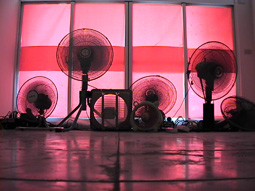
Fanclub, Fantilator-concert, Taipeh, Taiwan 2006. |
 |
 |
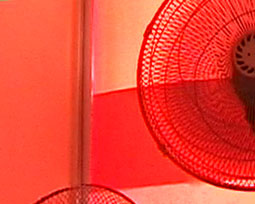 |
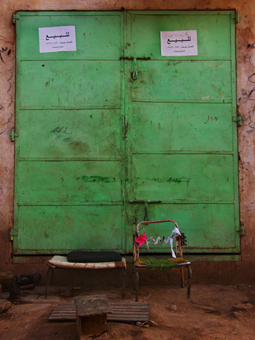
Klangstuhl, soundchair, Karthoum, Sudan 2007. |
 |
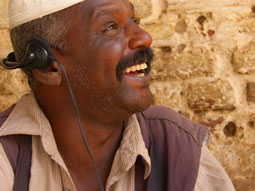 |
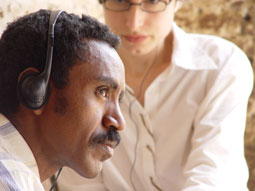 |